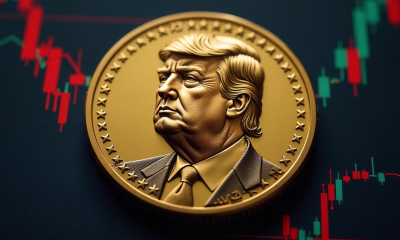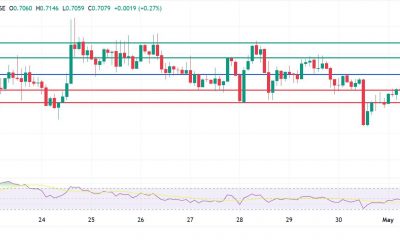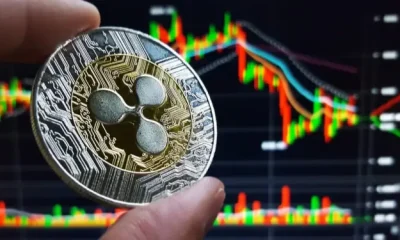

others
WTI recovers above $70.50 on fresh Iran sanctions – Crypto News
- WTI price trades in positive territory near $70.80 in Tuesday’s early Asian session.
- The US rolled out new Iran-related sanctions, lifting the WTI price.
- Trump’s tariff plans and war in Ukraine remain in focus.
West Texas Intermediate (WTI), the US crude oil benchmark, is trading around $70.80 during the early Asian session on Tuesday. The WTI price extends the recovery amid concerns of near-term supply tightness.
The United States (US) imposed a fresh round of sanctions, the Treasury and State Departments announced on Monday, targeting companies and individuals, including the head of Iran’s national oil company. This might add to concerns of near-term supply tightness, weighing on the WTI price.
On the other hand, traders will closely monitor the developments surrounding further tariff policies from US President Donald Trump. Concerns over a potential global trade war could limit further gains for black gold. US President Donald Trump said Monday that sweeping US tariffs on imports from Canada and Mexico “will go forward” when a month-long delay on their implementation expires next week.
Additionally, the thaw in US-Russian ties as well as possible peace talks on the Russia-Ukraine war might exert some selling pressure on the WTI price. This could eventually lead to reduced sanctions on Russia and the full resumption of Russian oil exports.
WTI Oil FAQs
WTI Oil is a type of Crude Oil sold on international markets. The WTI stands for West Texas Intermediate, one of three major types including Brent and Dubai Crude. WTI is also referred to as “light” and “sweet” because of its relatively low gravity and sulfur content respectively. It is considered a high quality Oil that is easily refined. It is sourced in the United States and distributed via the Cushing hub, which is considered “The Pipeline Crossroads of the World”. It is a benchmark for the Oil market and WTI price is frequently quoted in the media.
Like all assets, supply and demand are the key drivers of WTI Oil price. As such, global growth can be a driver of increased demand and vice versa for weak global growth. Political instability, wars, and sanctions can disrupt supply and impact prices. The decisions of OPEC, a group of major Oil-producing countries, is another key driver of price. The value of the US Dollar influences the price of WTI Crude Oil, since Oil is predominantly traded in US Dollars, thus a weaker US Dollar can make Oil more affordable and vice versa.
The weekly Oil inventory reports published by the American Petroleum Institute (API) and the Energy Information Agency (EIA) impact the price of WTI Oil. Changes in inventories reflect fluctuating supply and demand. If the data shows a drop in inventories it can indicate increased demand, pushing up Oil price. Higher inventories can reflect increased supply, pushing down prices. API’s report is published every Tuesday and EIA’s the day after. Their results are usually similar, falling within 1% of each other 75% of the time. The EIA data is considered more reliable, since it is a government agency.
OPEC (Organization of the Petroleum Exporting Countries) is a group of 12 Oil-producing nations who collectively decide production quotas for member countries at twice-yearly meetings. Their decisions often impact WTI Oil prices. When OPEC decides to lower quotas, it can tighten supply, pushing up Oil prices. When OPEC increases production, it has the opposite effect. OPEC+ refers to an expanded group that includes ten extra non-OPEC members, the most notable of which is Russia.
-

 Cryptocurrency1 week ago
Cryptocurrency1 week agoFirst 100 days under President Trump: crypto industry faces new challenges and opportunities – Crypto News
-

 Technology1 week ago
Technology1 week agoWaymo, Toyota Partner on Self-Driving Tech for Personal Vehicles – Crypto News
-

 Blockchain1 week ago
Blockchain1 week agoCrypto token failures soar, with 1 in 4 launched since 2021 dying in Q1: CoinGecko – Crypto News
-
Technology1 week ago
Here’s Why Shiba Inu Price May Skyrocket Soon – Crypto News
-

 Blockchain1 week ago
Blockchain1 week agoBitcoin Price Breakout Confirmed — Eyes on Next Key Level – Crypto News
-

 Technology1 week ago
Technology1 week agoOpenAI explains ‘THIS’ is why it reversed GPT-4o update amid sycophantic behavior concerns – Crypto News
-

 Cryptocurrency1 week ago
Cryptocurrency1 week agoCardano Price Finds $0.700 Support to Strengthen Upward Traction – Crypto News
-
Technology1 week ago
What’s Next for Bitcoin Price as BlackRock Moves to Launch $150B Fund? – Crypto News
-

 Technology1 week ago
Technology1 week agoGoogle’s Gemini AI could soon be built into iPhones, says CEO Sundar Pichai – Crypto News
-

 Technology1 week ago
Technology1 week agoAmazon Summer Sale 2025 is LIVE for Prime members: Up to 75% off on laptops, refrigerators, ACs and more – Crypto News
-
Cryptocurrency1 week ago
Cardano Founder Predicts What Next For Blockchain Innovation – Crypto News
-

 others1 week ago
others1 week agoAustralia’s Trade Surplus climbs to 6,900M MoM in March vs. 3,130M expected – Crypto News
-

 Technology1 week ago
Technology1 week agoAmazon Great Summer Sale is LIVE for Prime members: Big price drop of up to 45% on laptops across categories – Crypto News
-
Business1 week ago
Crypto Trader Made $300k As Solana-Based XAI Gork Price Skyrocket 191x, Here’s Why – Crypto News
-
others1 week ago
Bitcoin Price Prediction: BTC Eyes $145,000 Rally as Michael Saylor Launches Another $21B Plan – Crypto News
-
Business1 week ago
Here’s What to Expect From BTC, ETH, XRP & SOL as S&P500 Secretly Mirrors 1998 Cycle – Crypto News
-

 others1 week ago
others1 week agoUS State Paying $2,000,000,000 To Residents – No Strings Attached – in First-Ever ‘Inflation Rebate’ Program – Crypto News
-

 Cryptocurrency7 days ago
Cryptocurrency7 days agoXRP jumps 30% on Ripple news – Crypto News
-
Business1 week ago
North Carolina Approves Bill to Create Strategic Bitcoin Reserve Fund – Crypto News
-

 Cryptocurrency1 week ago
Cryptocurrency1 week agoShiba Inu, Ethereum prices waver as traders flock to this viral token – Crypto News
-

 Cryptocurrency1 week ago
Cryptocurrency1 week agoChainlink Price Prediction 2025-2027-2030: LINK To $1000? – Crypto News
-

 Cryptocurrency1 week ago
Cryptocurrency1 week ago$240M outflows amid tariff uncertainty – Crypto News
-

 Cryptocurrency1 week ago
Cryptocurrency1 week agoAnalysts Remain Bullish on Strategy’s Bitcoin Buying Plans – Crypto News
-
others1 week ago
Crypto Market Today: Top Trends Driving BTC, ETH, XRP & DOGE Prices – Crypto News
-
others1 week ago
Visa and Bridge Launches Stablecoin Payments In Latin America – Crypto News
-

 Cryptocurrency1 week ago
Cryptocurrency1 week agoBinance community vote puts FTT at highest delisting risk – Crypto News
-
Business1 week ago
WLD Price Eyes Breakout As Sam Altman’s Worldcoin Goes Live In US – Crypto News
-

 Blockchain1 week ago
Blockchain1 week agoWhy Saylor’s Billion-Dollar Bitcoin Buys Barely Move Price: Expert – Crypto News
-
others1 week ago
Kraken Q1 Performance Metrics Soar as IPO Hype Grows – Crypto News
-

 Cryptocurrency1 week ago
Cryptocurrency1 week agoTHREE reasons why Bitcoin is set to hit $107K next! – Crypto News
-

 others1 week ago
others1 week agoKey Fundamental Metrics for Memecoins in 2025 – Crypto News
-
Cryptocurrency1 week ago
Bitcoin ETFs Regain Momentum With $420M Inflow As BTC Price Eyes $100K – Crypto News
-
Technology1 week ago
Predicting Ethereum Price Target as ETH Mirrors Bitcoin’s Rally that Pushed it to $100k – Crypto News
-

 Cryptocurrency1 week ago
Cryptocurrency1 week agoRipple and SEC inch closer to resolution as April 16 looms – Crypto News
-

 others1 week ago
others1 week agoDow Jones soars 600 points as NFP data calms recession fears, weekly gains top 3% – Crypto News
-

 Cryptocurrency1 week ago
Cryptocurrency1 week agoFriday Charts: Will natural intelligence keep us employed? – Crypto News
-
Technology1 week ago
TRUMP Token as Reserve Asset? US Logistics Firm Freight Technologies To Hold TRUMP – Crypto News
-

 Blockchain1 week ago
Blockchain1 week agoPeter Brandt Predicts When Bitcoin Price Might Reach $150,000, Technical Signals Show Where Market Is At – Crypto News
-
Technology1 week ago
Bitcoin Price Eyes $100k as Saylor Buys $1.42B BTC — Fed Decision Looms – Crypto News
-

 others7 days ago
others7 days agoBullish momentum, buyers don’t give up – Crypto News
-
others5 days ago
Singapore Retail Sales (YoY) climbed from previous -3.6% to 1.1% in March – Crypto News
-
others5 days ago
Breaking: VanEck Files S1 Form With US SEC To Launch BNB ETF – Crypto News
-
others5 days ago
Breaking: VanEck Files S1 Form With US SEC To Launch BNB ETF – Crypto News
-
Technology5 days ago
ECB Kicks Off Digital Euro Testing with 70 Firms Across Europe – Crypto News
-

 Cryptocurrency5 days ago
Cryptocurrency5 days agoWill Bitcoin Fall Below $90K as Ethereum and XRP Lose Momentum? – Crypto News
-

 Business5 days ago
Business5 days agoRite Aid Files for Bankruptcy, Job Cuts Expected – Crypto News
-

 others1 week ago
others1 week agoBitMEX Founder Arthur Hayes Says Market Providing Stellar Entry Points for These Types of Protocols – Crypto News
-
Technology1 week ago
Ripple Offered $5 Billion To Buy USDC Issuer Circle: Bloomberg – Crypto News
-

 Blockchain1 week ago
Blockchain1 week agoFunding surge targets confidentiality, tokenization and Web3 infrastructure – Crypto News
-

 others1 week ago
others1 week agoAustralia’s Trade Surplus climbs to 6,900M MoM in March vs. 3,130M expected – Crypto News



![Nvidia will reveal its Q4 earnings today, after the bell [Video]](https://dripp.zone/news/wp-content/uploads/2025/02/Nvidia-will-reveal-its-Q4-earnings-today-after-the-bell-400x240.png)
![Nvidia will reveal its Q4 earnings today, after the bell [Video]](https://dripp.zone/news/wp-content/uploads/2025/02/Nvidia-will-reveal-its-Q4-earnings-today-after-the-bell-80x80.png)





